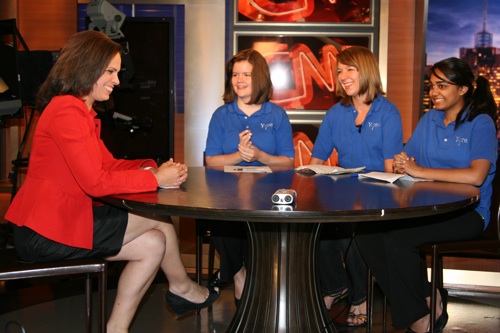Power of the Question
Lesson 4: Pushing and Probing Questions
Resources/materials
- White board or chalkboard;
- Chart paper and markers;
- Index cards;
- Classroom computer with access to the internet;
- Overhead or computer projector and screen;
- Dictionary and thesaurus;
- Types of questions list from the Y-Press project, provided here;
- Large bowl
WARM-UP ACTIVITY
In the final section of the video, O’Brien discusses the importance of asking interview questions that push and probe. Have students write in their journal in response to the following prompt: Using your homework assignment, how did the reporter push an interviewee to respond to a question. Was this pushing necessary? How did it have an impact on the quality of the interview? Share responses with class.
CONCEPT FORMATION
Show push and probe O’Brien video, including an interview with FEMA director Michael Brown.
After viewing, ask the class the following questions:
- Did O’Brien push or take her questions far enough to get the answers she wanted?
- How can you get an answer from someone you are interviewing?
- Did she settle for her first answer or a brief answer to her questions? Why or why not?
- What tone did she take in the interview? Did she remain respectful throughout the interview?
- How would you have reacted and what questions would you have asked?
Identify one question from O’Brien’s interview that exemplifies pushing and probing. Write question on board. Introduce different question types by reviewing the Y-Press “types of questions” handout (link). Identify the question types that encourage pushing and probing. Two question types that are relevant are “out-on-a-limb” and “devil’s advocate.”
Pass out index cards to the class. Have half of the class develop examples of “out- on-a-limb” questions and write this question on the index card.
Examples might include:
- If you had to lose one of your five senses (hearing, sight, smell, touch, and taste), which one would it be and why?
- If money was no object and you could live anywhere in the world, where would you live and why?
- Someone died and left you a million dollars. What would you do with it and why?
Have the other half of the class develop examples of “devil’s advocate” type questions and write this question on the index card.
Examples might include:
- Pretend you are a cosmetic surgeon. One day a person comes up to you and says that what you are doing is morally wrong. What would you say to that person and why?
- You are accused of starting a rumor about someone else that you know is not true. How would you respond to claims that you started this rumor?
Have the students place their index card in a bowl at the front of the room. Pass the bowl around the room and have each student draw out a question. Pair students and have them discuss the questions they drew. Students should be able to determine if they have an “out-on-a-limb” or “devil’s advocate” question. After several minutes, discuss their questions. Some questions to ask include:
- Were these probing questions? Did they make you stop and think?
- Did you feel challenged to answer these questions? Why or why not?
- Thinking back to Soledad O’Brien’s interviews, how can you make your questions more probing?
- How can you push someone to reflect or think about their answers in more detail?
After activity, ask students to consider how these types of questions help journalists get information about controversial issues, particularly when the interviewee does not want to talk about them. Frame the conversation by encouraging students to think about the cost of not asking questions: What happens when questions are not asked?
APPLICATION
Select a current event and ask students to develop “out-on-a-limb” or “devil’s advocate” questions for a key player in an international conflict. Use research from recent newspapers and magazine about the conflict. Divide students into four groups; each will represent a different point of view in order to question the leader about his or her course of action (teacher can role play the leader). If the conflict is between countries, each group can summarize the country’s stance. Then allow groups time to brainstorm questions and select a spokesperson to ask the “opening out-on-a-limb” or “devil’s advocate” question.
Discuss the role play discuss which questions were effective, how tone played a role in the question asking, which questions were missing and when the group believed it was important to push. Alternatively, this activity can be accomplished using a protagonist from a novel or historical figure.
HOMEWORK
Students should pretend to be a world leader and write a monologue offering potential solutions and the factors influencing his decision. In much the same style as the “To Be or Not to Be” soliloquy in Shakespeare’s “Hamlet,” these speeches should trace the hypothetical internal decision-making process. Each monologue should identify courses of action and include reasons for each choice. These monologues can be shared in a future class.
EXTENSIONS
Video project. In 2007, as O’Brien was trying to find an angle for covering the recovery two years after Katrina and portray the future of New Orleans, she found a unique approach — hand cameras to 11 young people. In early 2007, she and Spike Lee challenged young people to document the changes and their daily lives. The result was the “Children of the Storm” documentary.
Show class footage from Soledad O’Brien’s “Children of the Storm” documentary, which begins with the story of Amanda Hill, 18, and then& O’Brien’s and Lee’s challenge to the students.
» Video projects
Brainstorm ideas for class video projects. Come up with a list of five to seven topics that interest the students.
Separate class into teams of three or four students. Ask each team to select one topics. Each team member will take a role such as cameraman, editor, interviewer, etc. Have each team research their topic and come up with a list of questions based on their research.
The teams should arrange and conduct interviews during class time if possible. After the teams have conducted their interview have them edited the short films. Have a viewing of all the video projects during class and/or a special showing for the entire school. Post videos to a school website.
» On-the-spot interviews
Y-Press journalists did not give Soledad O’Brien their questions prior to their interview. Often reporters use an “on-the-spot” questioning style. Share an example of the following video: The Killers interview.
In order to practice an “on-the-spot” interview, using chairs have students form both an inner circle and outer circle. Inner circle students should be paired up with an outer circle student. Have students write two questions, one “out-on-a-limb” and one “devil’s advocate.” Their questions should be focused what they want to know about each other and why. If you have time encourage students to pose follow-up questions to each other.
Depending on time constraints have either the inner or outer circle rotate so that students are paired up with somebody new.
» Informal debates
Have an informal debate with students on an issue. The instructor will play “devil’s advocate” by shifting from one side of the argument to the other. This may be an especially useful exercise if a significant majority of students share the same views on an issue, or if one side appears weaker. The instructor can serve as a model for good debate tactics.
Standards
This lesson meets content and skill standards across the middle and high school curriculum. In particular, this lesson addresses standards related to communication, research skills, critical thinking, and inquiry. Such standards can be found in a range of different disciplines, including Language Arts, Social Studies, Technology, Journalism, and Science. We encourage you to review state standards to determine what standards are applicable to your classroom. National Standards may also prove helpful and can be located at:
- National Council for Teachers of English
- National Council for the Social Studies
- National Educational Technology Standards
- Journalism Education Association
- If no state standards for journalism exist, see Language Arts. For Indiana, IN-JRN 4 (Journalistic Writing Processes): (For more specific explanation, please see this pdf.
- National Science Education Standards



